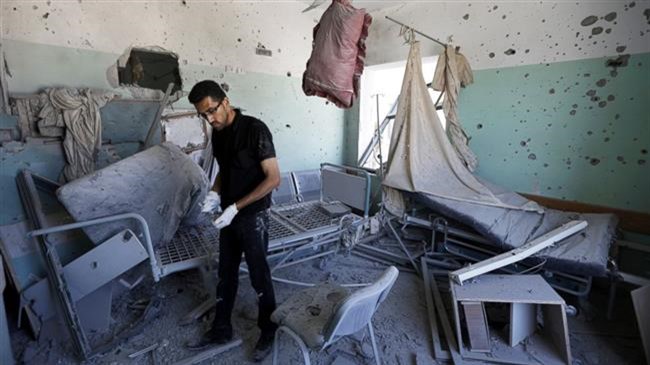The Collapsing Health Care System In War Torn Palestine

NEW DELHI: It was evident that the failure to implement the Two State solution of an independent State of Palestine together with the State of Israel would lead to an unbalanced political scenario, but it was hardly known that the repercussions would be seen even today in the healthcare system that functions in an atmosphere of protracted conflict over decades now.
At the height of the war almost 47.3% of all public health services were fighting a secret battle trying to cope up with resource restrictions, poor infrastructure and untrained medical staffs. This also led to decrease in hospital bed capacities from 2,678 to 2,428, reduction in surgical theatres and finally closure of 11 out of 31 functioning hospitals that contributed 35.48% of total public health services in the region. These are only few of the several barriers that the healthcare system faces. Major challenges to healthcare today ranges from the existing socio economic structures to modern day infrastructure requirements as well outdated treatment protocols and ambiguous disease approaches.
Redirecting facts along the timeline of the conflict in 1995 the healthcare system needed about $48.8 million ($21.8 million in Gaza and $27 million in the West Bank) to effectively develop institutions working towards healthcare, rehabilitation and patient management. In only a year just the operational cost of healthcare rose to $107million and the average revenues collected were mere $44 million incurring a fiscal debt of $68 million on the healthcare system. At this point only 30.5% people of the total population benefiting from healthcare were paying taxes making the system completely depend on international help, aides and donations to cover up for the huge debt it had acquired.
The shift in dependency level would have been achieved if the population had been on regular employment balancing the healthcare system with fast generating revenues as taxes. The unfortunate picture still lies within the state and all these today have synergistically added up to be a growing financial burden on the present day healthcare services.
Though there has been some development in this scenario with frequent interventions by United Nations, UNRWA and WHO but the economic atmosphere still remains null and void effecting the public health services the most.
In the year 2013 the World Bank reported, that the GDP growth of the occupied Palestinian territories; GAZA and West Bank was -4.4%. This growing financial depression had not only effected other commodities but also had tragic consequences on the healthcare system. Lack of public investment, fewer establishment of multi-specialty hospitals and chronic financial conditions makes the current system highly retain bold avulnerable even with the present interventions.
(The annual GDP % growth reflecting The World with West Bank, Gaza and Israel showing the consistent fall in GDP growth of these regions in the years of conflict finally reaching a negative value in 2013(Adapted from The World Bank- West Bank & GAZA)
Over the last decade there has been a major shift in the epidemiological data on disease occurrences in the occupied Palestinian territories. At present the third highest cause of mortality is cancer with breast cancer being the highest reported cases in females with 5 year survival rates as low as 30-40%. The main treatment barriers in this case that effect the disease outcomes are lack of modern diagnostic techniques, social, cultural stigmas and access restrictions. Only 44% of all Palestinians have access to customary and adequate health facilities which are further restricted now due to falling standards of healthcare with improper preventive care and lifetime choices.
(Mortality ratio from 1999-2003 in Occupied Palestinian Territories, adjusted for age and sex, adapted from the work of Rmeileh et al,. 2008)
Though the attitude in willingness to be treated has changed but access to healthcare is still an unsolved paradigm. As most hospitals in GAZA and West Bank do not have first-hand technology to treat chronic illnesses patients have to sometime travel to either east Jerusalem or Cairo which is a 12 hour journey with multiple checkpoints. Most people have to manage these travel expenses and treatment by selling their lands and commodities. The recent rise in migration rates in several parts of Eastern Europe are examples of this imbalanced society.
The unfairness in referrals as well as access restriction has not only lead to increase in mortality ratio but simultaneously added up to an economy at the brink collapse. From 2000 to 2013 the expenditure on referrals had increased from US$8 million to US$144 million which was equivalent to almost 40% of Palestine’s Authority health spending outside of salaries.
It’s only shocking to see that 22 medical centres, clinics had been affected by the conflict further with closure of 4 hospitals and 27 primary health centres as they were justified to be in un safe zone. About 1100 civilians have been killed in protection operation and a quarter of the dead population include children.
The poor condition of health services are just a major outcome of resistance and retribution that has been expressed in these areas over years. Today GAZA and West Bank suffer one of the worst humanitarian crisis. At this point along with cooperation, coexistence we need a fair system that encourages equal access to health facilities beyond the geographical divisions of inequality.
(Adapted from palmuseum.wordpress.com)



